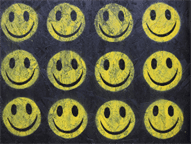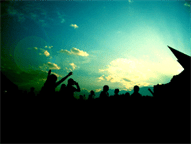Could Acid House have happened in the Internet age?
Wednesday, March 9, 2016
by Tat
Since the 1970s there have been three great youth movements and scenes, punk, hip hop and acid house. Of course there have been countless other scenes that have paralleled and branched off from them, new wave, grime, drum and bass, deep house, the list goes on. Yet these are the three greatest youth movements of the back end of the 20th Century and we have seen nothing like them since. All three share the common theme that they in time dominated the music scene. They may not sound like they did at their source and have morphed from their original purist sounds but more importantly all three happened before the advent of Web.
According to which source you listen to, the last of three great scenes, acid house appeared in 1985, six years before Sir Tim Berners Lee switched on the World Wide Web as we know it from his lab in CERN, Switzerland. Since then the web has gone from strength to strength and impacts most aspects of our lives, especially if you are under the age of 45. And 45 is about the cut off point for anyone who was originally involved in the acid house scene, even by the time rave appears in the late 80s the average 18-year-old back then would now be at least 45-years-old.
Pre-Internet dance movement
The setting for the acid house and rave scenes were ripe when they happened, we were under a Tory Government, there was unrest in society due to job cuts, threats to the NHS, national security and pensions. People were unhappy and needed an outlet and like the working classes of the 1970s in the North and their aptly named northern soul they found it via dance music.
Pre-Internet scenes all had to work hard to build up and survive, there was no easy way for music to be heard or shared. It was like some primordial creature pulling itself from the water to stand on it's own newly formed legs, acid house was an evolutionary step done the hard way. If you wanted to hear rave music in the late 80s and early 90s you either needed to be in a club, live in a town or city with a cool record shop or live in earshot a pirate radio station. Promoting a night from scratch was not always that easy and usually revolved around badly photocopied fliers and posters knocked up in the dead of night. Yet in areas where critical mass was building on the rave scene the word was spread across the club networks and mass raves started to appear in warehouses, airplane hangars and in fields. Yet all this happened without the web, just thanks to a tight network of record shops, pirate radio stations, fliers and word of mouth. So for that reason this was perhaps that's why it happened like it did. The scene grew at the right pace, yet one step ahead of the authorities that tried to stamp it out.
Staying one step ahead
For raves to happen they had to be one step ahead of the police as they could be shut down in a moment's notice. Under the Tory Government they used heavy handed tactics to shut down any illegal raves they came across and didn't like. Remember that we were just a couple of years on from the Miner's Strike, and a collection of furious inner-city riots, the police had learned well how to deal with mass civil disobedience. In 1994 the Tories introduced their Criminal Justice and Public Order Act which had big implications for mass raves. Given how short some scenes last these days, it is perhaps a blessing that the illegal rave scene that ran from 1988-1994 lasted so long. In a world connected to the web that period could have been much shorter as the scene would have no doubt expanded too quickly and gained too much attention too early on. The likes of early club promoters and DJs could have been stifled by such a paradigm shift and by the time it broke many were in a good place to nurture a scene of epic proportions. Of course in time there was all the coverage in the red top newspapers about the ‘evil acid house scene' but even then there was still an incredible amount of misinformation going on. Hardly anyone really knew what was happening, the promoters stayed one step ahead of the media and authorities and those involved including the clubbers protected the secret location of raves.
In an age of GPS, social media and Google Maps such a scene could have struggled from the start. The cat and mouse antics of ravers and police on the M25 might have been less fun if the police got their tip offs from a careless social media posting rather than scouting the motorways and service stations for large groups of young ravers. Whilst photographic content shared on a social web could have lead to quicker prosecutions which would have stifled the fledgling scene.
Many raves went off without gaining attention and were able to build into regular nights and were probably akin to the same rules of sampling and copyright today. This being that most artists can sample tracks and not pay royalties but the moment that new track becomes a hit the person who was sampled takes notice and wants a slice of any new royalties. The same happened with the raves, once the message spread to interested parties, either criminals looking to make money or authorities to shut them down their days were numbered.
Could we ever see such a scene again?
In the end rave evolved into a multitude of other scenes, jungle, trance, progressive house, breakbeat to name but a few. Many of these also predated the web and it wasn't until the turn of the 21st Century that people started to connect online in their masses. By then hip hop and dance music had become part of the institution, the scenes had grown up and become serious business on a global scale. That was partially thanks to the web, but also because the scenes had been allowed the time to grow and adapt. It could be argued that many youth and music scenes that have followed have struggled to build such momentum, often their light burns brightly but for such a short time. Yet the power of house music is perhaps a testament to the web coming along when it did, it helped push the sound out to the farthest corners of Asia, Africa and South America. Back in the day the footprint of dance music was quite small and by the mid 90s still had not got much further than Western Europe. Now everyone can access the global sounds of dance, witness a club from another continent for themselves and chat with fellow music lovers in another time zone. With all that in mind it should follow that any future huge movements like hip hop, house and punk should happen even more so. In fact given how the world is connected it should also mean that the U.S. may not have the monopoly on such a future ventures, that perhaps it will come from Africa, East Europe or Asia. Yet thirty years on it hasn't happened as far as I'm aware, but maybe, just maybe a massive scene is happening and building, it's just that we've not seen it yet.
Get todays music with Trackhunter on Mac, iOS or Windows







